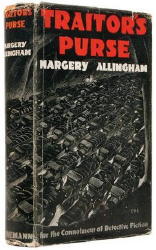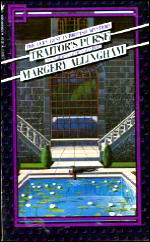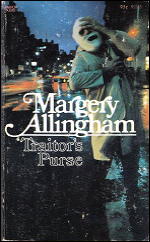Thu 26 Jan 2012
A 1001 MIDNIGHTS Review: MARGERY ALLINGHAM – Traitor’s Purse.
Posted by Steve under 1001 Midnights , Reviews[3] Comments
by Thomas Baird

MARGERY ALLINGHAM – Traitor’s Purse. Doubleday Crime Club, US, hardcover, 1941. First published in the UK: Heinemann, hardcover, 1941. Reprinted many times, in both hardcover and paperback.
England is at war. The country is threatened by a catastrophic stroke, and time is desperately short. All lines of investigation have gone slack, and only one man knows the enormity of the situation. Only one man has the faintest clue to the heart of the conspiracy. As the story opens, Albert Campion awakes in a hospital bed with total amnesia from a blow to the head.
Hearing himself described as the killer of a policeman, he recklessly escapes and heads for the Bridge Institute, a research organization that is “a living brain factory.” The Masters of Bridge are a hereditary group who are the governors of the Institute, and Sir Henry Bull is one of the Senior Masters. When the secretary to the masters is killed, the police question Campion, who was the last man to see him alive.

Campion’s investigations are invested with the psychology of paranoia. He walks a tightrope, of sifting clues while trying to reestablish his memory. Stanislaus Oates, head of the CID, has disappeared, and Campion can’t confide his memory loss to his love interest, Amanda, because of her trust in him.
The only really practical help that comes his way is from his man, Magersfontein Lugg, who recognizes what a blow to the head can do and protects Campion from the police manhunt and from the gang of criminals on his track.
The search for the traitor weaves through the criminal conspiracy and the institute itself (and by extension into the government) and leads into the cavernous heart of Nag’s Head, the rocky headland that looms over the town of Bridge.
Many characters appear, disappear, and reappear throughout the saga, including friends and relations; the policemen Oates, Yeo, and Luke; and the spymaster L. C. Corkran.

This story is Campion’s trial by fire — afterward he is a changed man. Later in his career, he has less to do and becomes a sort of consultant.
After Allingham’s death, her husband continued the Campion adventures in three more novels. One novel that has received much critical approval, The Tiger in the Smoke (1952), in some ways seems overdrawn and overwritten.
Other recommended titles by Allingham are Mystery Mile (1930), Look to the Lady (1931), Sweet Danger (1933), and More Work for the Undertaker (1948). Inducements to read them include the memorable names of characters, both major and minor, and of the various settings. And if you’re a fan of that Golden Age staple, a proper plan or map of the scene, these provide cartographic delight.
———
Reprinted with permission from 1001 Midnights, edited by Bill Pronzini & Marcia Muller and published by The Battered Silicon Dispatch Box, 2007. Copyright © 1986, 2007 by the Pronzini-Muller Family Trust.
January 26th, 2012 at 12:18 pm
I suspect, although I am not 100% positive, that the maps and lists of characters Thomas Baird refers to in his last paragraph do not exist in the various reprint editions of Margery Allingham’s books.
Would that they did, though! Inducements they are indeed, particularly for books of a certain vintage, or in that Golden Age style.
Speaking for myself, while Traitor’s Purse may have been a tipping point in Mr. Campion’s career, I made the mistake at an early age of reading this one of his adventures first.
I confess I did not know what to make of it. I was expecting something in the line of Agatha Christie, John Dickson Carr, Ellery Queen or Ngaio Marsh at the time, and as you see from reading the review above, that is not what I got.
I don’t remember thinking it a bad book, not at all, but I did not go back to reading Margery Allingham for a long time after that. Of all of the most well known authors writing in the Golden Age of Detection, it is her work I’ve read the least of.
January 26th, 2012 at 4:32 pm
I’ve always felt that she was really a thriller writer who also wrote detective fiction. Looking at the Campion novels, I think that less than half are bona fide whodunnits. She could and did write proper detective novels, but she couldn’t resist putting in other stuff into them.
TIGER IN THE SMOKE: Overdrawn and overwritten? I read it in one sitting on holiday many years ago, and literally couldn’t put it down. Brilliant book.
TRAITOR’S PURSE is interesting in that the villain’s plot later turned out to have been used by the Germans during WWII. Thankfully it was never properly carried out, and didn’t have the expected effect.
January 26th, 2012 at 5:00 pm
Bradstreet —
TIGER IN THE SMOKE is not one of the Campion’s I’ve read, so I can’t address the statement myself, but you’re not alone in thinking it one of Allingham’s best.
Mike Ripley includes it as one of his favorite thriller novels: https://mysteryfile.com/blog/?p=5356, for example, and David Vineyard gave it an all-out rave review here on this blog a couple of years ago: https://mysteryfile.com/blog/?p=2281
When you say that “I’ve always felt that she was really a thriller writer who also wrote detective fiction,” I think you’re quite right. At the time I read TRAITOR’S PURSE, it was not what I was looking for, which was a traditional detective story. Sometime when I can, I’ll read it again.